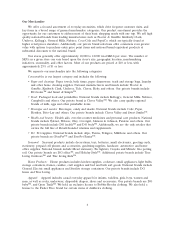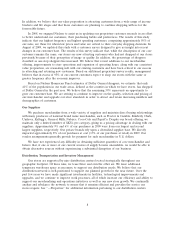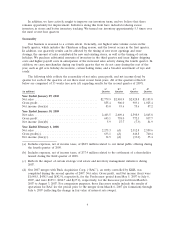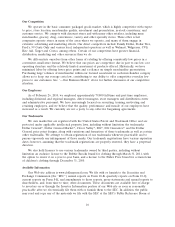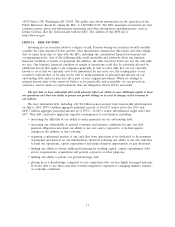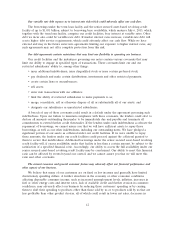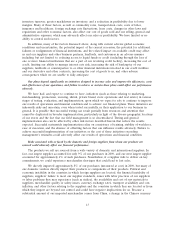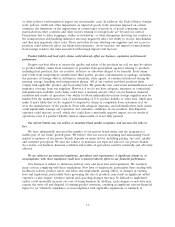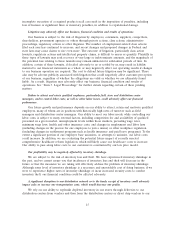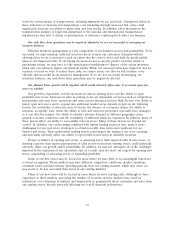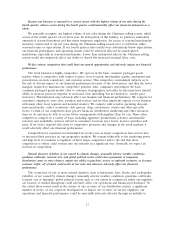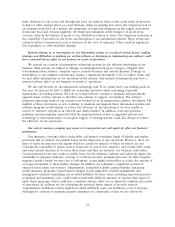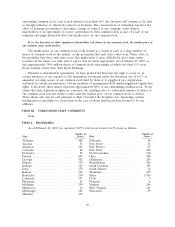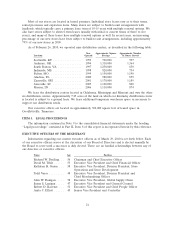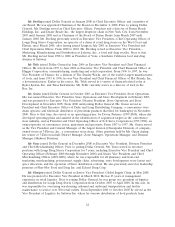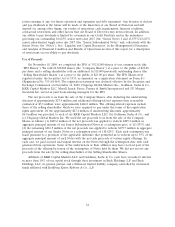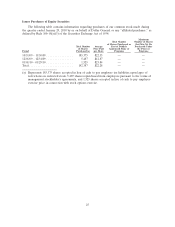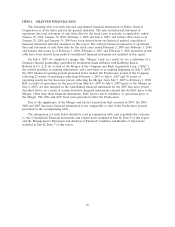Dollar General 2009 Annual Report Download - page 27
Download and view the complete annual report
Please find page 27 of the 2009 Dollar General annual report below. You can navigate through the pages in the report by either clicking on the pages listed below, or by using the keyword search tool below to find specific information within the annual report.stores by various means of transportation, including shipments by sea and truck. Unexpected delays in
those deliveries or increases in transportation costs (including through increased fuel costs) could
significantly decrease our ability to make sales and earn profits. In addition, labor shortages in the
transportation industry or long-term disruptions to the national and international transportation
infrastructure that lead to delays or interruptions of deliveries could negatively affect our business.
Our cash flows from operations may be negatively affected if we are not successful in managing our
inventory balances.
Efficient inventory management is a key component of our business success and profitability. To be
successful, we must maintain sufficient inventory levels to meet our customers’ demands without
allowing those levels to increase to such an extent that the costs to store and hold the goods unduly
impacts our financial results. If our buying decisions do not accurately predict customer trends or
purchasing actions, we may have to take unanticipated markdowns to dispose of the excess inventory,
which also can adversely impact our financial results. While our inventory turns have improved and we
continue to focus on ways to reduce these risks, we cannot assure you that we will continue to be
efficient and successful in our inventory management. If we are not successful in managing our
inventory balances, our cash flows from operations may be negatively affected.
Our planned future growth will be impeded, which would adversely affect sales, if we cannot open new
stores on schedule.
Our growth is dependent on both increases in sales in existing stores and the ability to open
profitable new stores. Increases in sales in existing stores are dependent on factors such as competition,
merchandise selection, store operations and other factors discussed in these Risk Factors. Our ability to
timely open new stores and to expand into additional market areas depends in part on the following
factors: the availability of attractive store locations; the absence of occupancy delays; the ability to
negotiate acceptable lease terms; the ability to hire and train new personnel, especially store managers
in a cost effective manner; the ability to identify customer demand in different geographic areas;
general economic conditions; and the availability of sufficient funds for expansion. In addition, many of
these factors affect our ability to successfully relocate stores. Many of these factors are beyond our
control. In addition, our credit ratings combined with tighter lending practices have made it more
challenging for our real estate developers to obtain favorable loan terms and conditions for our
build-to-suit stores. These unfavorable lending trends could impact the timing of our store openings
and materially adversely affect our ability to open build-to-suit stores in desirable locations.
Delays or failures in opening new stores, or achieving lower than expected sales in new stores, or
drawing a greater than expected proportion of sales in new stores from existing stores, could materially
adversely affect our growth and/or profitability. In addition, we may not anticipate all of the challenges
imposed by the expansion of our operations and, as a result, may not meet our targets for opening new
stores, remodeling or relocating stores or expanding profitably.
Some of our new stores may be located in areas where we have little or no meaningful experience
or brand recognition. Those markets may have different competitive conditions, market conditions,
consumer tastes and discretionary spending patterns than our existing markets, which may cause our
new stores to be less successful than stores in our existing markets.
Many of our new stores will be located in areas where we have existing units. Although we have
experience in these markets, increasing the number of locations in these markets may result in
inadvertent over-saturation of markets and temporarily or permanently divert customers and sales from
our existing stores, thereby adversely affecting our overall financial performance.
16


